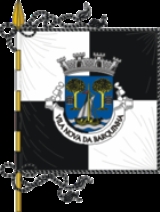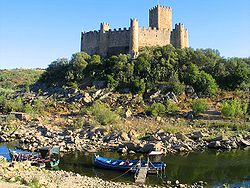
Vila Nova da Barquinha
Encyclopedia
Vila Nova da Barquinha (ˈvilɐ ˈnɔvɐ ðɐ βɐɾˈkiɲɐ) is a municipality in Portugal
with a total area of 49.6 km² and a total population of 7,878 inhabitants. It is composed of 5 parishes and is located in the district of Santarém
.
The village of Vila Nova da Barquinha, which is the seat of the municipality, has 3500 inhabitants.
The present Mayor is Vítor Miguel Pombeiro, elected by the Socialist Party
.
The municipal holiday is June 13.
period, when the river Tagus
, which flows through the South of the municipality, was the border between the dominions of Christians and Moors
. In the 12th century, the defence of this border was in charge of the Knights Templar
, who built several castles along the river. One of these is the Castle of Almourol
, built by the Master of the Portuguese Templars, Gualdim Pais
, in 1171. The picturesque castle is located on an island in the Tagus river and can be visited by boat. Nowadays it is the most visited historical site in Vila Nova da Barquinha.
 In the end of the 13th century, when the Reconquista was finished, the importance of the castles of the region declined. The villages along the Tagus then became important fluvial ports for the transport of agricultural goods of the region to Lisbon
In the end of the 13th century, when the Reconquista was finished, the importance of the castles of the region declined. The villages along the Tagus then became important fluvial ports for the transport of agricultural goods of the region to Lisbon
. In the 16th century, the port of the village of Tancos became the most important of all, being granted a foral
(letter of feudal rights) in 1517 by King Manuel I
. From the early 16th century date the main church (matriz) of the village of Atalaia, with a magnificent portal and interior in Renaissance
style.
The village of Vila Nova da Barquinha, current seat of the municipality, was created in the 17th century around a fluvial port (hence the name Barquinha = Barca = Boat). In the 18th and 19th centuries the village became the most important in the region, and it was turned into the seat of the municipality in 1836. The importance of the river in the development of the municipality is reflected in its coat-of-arms, which shows the picture of a boat. The arrival of the railway system in Portugal eventually led to the decadence of the fluvial commerce of the municipality.
Portugal
Portugal , officially the Portuguese Republic is a country situated in southwestern Europe on the Iberian Peninsula. Portugal is the westernmost country of Europe, and is bordered by the Atlantic Ocean to the West and South and by Spain to the North and East. The Atlantic archipelagos of the...
with a total area of 49.6 km² and a total population of 7,878 inhabitants. It is composed of 5 parishes and is located in the district of Santarém
Santarém (district)
The District of Santarém is located in Centro Region, Portugal, the district capital is the city of Santarém.It has an area of 6747 km² , and a population of 475,344 inhabitants.-Municipalities:...
.
The village of Vila Nova da Barquinha, which is the seat of the municipality, has 3500 inhabitants.
The present Mayor is Vítor Miguel Pombeiro, elected by the Socialist Party
Portuguese Socialist Party
The Portuguese Socialist Party was a political party in Portugal.The party was founded in 1875. During its initial phase the party was heavily influenced by Proudhonism, and rejected revolutionary Marxism. The party suffered constant factional struggles...
.
The municipal holiday is June 13.
History and sights
Although some villages of Vila Nova da Barquinha are ancient, the development of the region is strongly related to the ReconquistaReconquista
The Reconquista was a period of almost 800 years in the Middle Ages during which several Christian kingdoms succeeded in retaking the Muslim-controlled areas of the Iberian Peninsula broadly known as Al-Andalus...
period, when the river Tagus
Tagus
The Tagus is the longest river on the Iberian Peninsula. It is long, in Spain, along the border between Portugal and Spain and in Portugal, where it empties into the Atlantic Ocean at Lisbon. It drains an area of . The Tagus is highly utilized for most of its course...
, which flows through the South of the municipality, was the border between the dominions of Christians and Moors
Moors
The description Moors has referred to several historic and modern populations of the Maghreb region who are predominately of Berber and Arab descent. They came to conquer and rule the Iberian Peninsula for nearly 800 years. At that time they were Muslim, although earlier the people had followed...
. In the 12th century, the defence of this border was in charge of the Knights Templar
Knights Templar
The Poor Fellow-Soldiers of Christ and of the Temple of Solomon , commonly known as the Knights Templar, the Order of the Temple or simply as Templars, were among the most famous of the Western Christian military orders...
, who built several castles along the river. One of these is the Castle of Almourol
Castle of Almourol
The Almourol Castle is situated in the small Almourol island, a rocky island, in the middle of the Tagus river , in Praia do Ribatejo, a parish in Vila Nova da Barquinha, Central Portugal. The castle was a Knights Templar stronghold used during the Reconquista.-The conquest of the castle:The site...
, built by the Master of the Portuguese Templars, Gualdim Pais
Gualdim Pais
Dom Gualdim Pais , a Portuguese crusader, Templar, Friar and Knight in the service of Afonso Henriques of Portugal, was the founder of the city of Tomar.-Biography:...
, in 1171. The picturesque castle is located on an island in the Tagus river and can be visited by boat. Nowadays it is the most visited historical site in Vila Nova da Barquinha.

Lisbon
Lisbon is the capital city and largest city of Portugal with a population of 545,245 within its administrative limits on a land area of . The urban area of Lisbon extends beyond the administrative city limits with a population of 3 million on an area of , making it the 9th most populous urban...
. In the 16th century, the port of the village of Tancos became the most important of all, being granted a foral
Foral
thumb|left|200px|Foral of Castro Verde - PortugalThe word foral derives from the Portuguese word foro, ultimately from Latin forum, equivalent to Spanish fuero, Galician foro, Catalan furs and Basque foru ....
(letter of feudal rights) in 1517 by King Manuel I
Manuel I of Portugal
Manuel I , the Fortunate , 14th king of Portugal and the Algarves was the son of Infante Ferdinand, Duke of Viseu, , by his wife, Infanta Beatrice of Portugal...
. From the early 16th century date the main church (matriz) of the village of Atalaia, with a magnificent portal and interior in Renaissance
Renaissance
The Renaissance was a cultural movement that spanned roughly the 14th to the 17th century, beginning in Italy in the Late Middle Ages and later spreading to the rest of Europe. The term is also used more loosely to refer to the historical era, but since the changes of the Renaissance were not...
style.
The village of Vila Nova da Barquinha, current seat of the municipality, was created in the 17th century around a fluvial port (hence the name Barquinha = Barca = Boat). In the 18th and 19th centuries the village became the most important in the region, and it was turned into the seat of the municipality in 1836. The importance of the river in the development of the municipality is reflected in its coat-of-arms, which shows the picture of a boat. The arrival of the railway system in Portugal eventually led to the decadence of the fluvial commerce of the municipality.
Population
| Population of Vila Nova da Barquinha municipality (1849 – 2004) | |||||||
|---|---|---|---|---|---|---|---|
| 1849 | 1900 | 1930 | 1960 | 1981 | 1991 | 2001 | 2004 |
| 3034 | 4336 | 9011 | 6547 | 8167 | 7553 | 7610 | 7878 |

